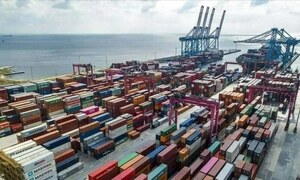LUMS submits report to FBR: Cement industry to pay Rs 29.72 billion as IT per annum
The cement industry has to pay an estimated Rs 29.72 billion as income tax per annum on the basis of 34 percent corporate income tax rate, exports and profits earned by the manufacturers etc. It is learnt on Monday that the report on 'Tax compliance and measures to counter tax evasion in Pakistan-sector analysis for cement industry' submitted by the LUMS Lahore to the Federal Board of Revenue (FBR), revealed estimated revenue of Rs 29.72 billion as income tax from cement sector per annum. The FBR has endorsed the findings of the report.
According to the report, the estimates of the potential income tax collection from the cement sector show that total profit is Rs 87.42 billion and the average profit made by each cement firm is Rs 2.91 billion. However, there is considerable variation in the profits across firms measured by the standard deviations. The highest estimated profit by a firm comes out to be Rs 10 billion whereas the lowest profit is only Rs 1.4 million. Based on an income tax rate of 34%, the industry as a whole should pay around Rs 29.72 billion as income tax. This implies that each firm, on average should be paying Rs 0.99 billion as Income tax.
The study's results can be made more precise if data on exports made by each firm is made available to the experts engaged in carrying out the study. Some firms export a bigger fraction of their output while others export a small fraction of their output or do not export at all. Therefore, firms exporting a bigger portion of their output pay sales tax on a smaller fraction and end up with a higher profit. Therefore, their income tax liability will be higher as well, it said.
For assessing income tax liability of the cement sector, the report said to calculate income tax liability of each firm, the researchers proceeded as follows. First, it was estimated the actual production value for each firm. These estimates are based on the inefficiency/misreporting factors.
Next, the report estimates the values of inputs used by each firm by employing industry level input-output ratio for each firm. The experts add these values to arrive at the total expenditure made on the inputs. It has been assumed that firms pay a depreciation cost of 9 percent on both capital and plant.
Finally, the experts deducted a constant fraction of total output value from the total output value in lieu of exports made by these firms. Since, experts do not have firm level data on the value of exports made by each firm; we use the industry level data and aggregate figures provided by the FBR to approximate the fraction of total output that is exported. The remaining output is for sale in the local market and we deduct expenditure on inputs from this value to arrive at the estimated profits for each firm. The experts used an income tax rate of 34 percent to calculate the approximate income tax that should be paid by each firm.
The report said that the total profit for the cement industry comes out to be Rs 87.42 billion, which implies an average profit per firm of around Rs 2.91 billion. However, the standard deviation shows considerable variation in the profits earned by different firms of different sizes. The highest estimated profit comes out to be Rs 10 billion whereas the lowest profit is only Rs 1.4 million.
Based on an income tax rate of 34 percent, the industry as a whole should pay around Rs 29.72 billion as income tax. This implies that each firm, on average should be paying Rs 0.99 billion as income tax. The results can be made more precise if data on exports made by each firm is made available to the researchers. Some firms export a bigger fraction of their output while others export a small fraction of their output or do not export at all. Therefore, firms exporting a bigger fraction of their output pay sales tax on a smaller fraction and end up with a higher profit. Therefore, their income tax liability will be higher as well.
The report documented the processes of cement production in the light of information collected from different firms. Interviews conducted with industry professionals suggest that production technology used by the firms in this sector is almost similar due to which there are no obvious advantages in the production cycle of any firm.
Cement has adhesive and cohesive properties which help bond mineral fragment into a compact and rigid mass. It may be classified into two broad groups: non-hydraulic cement and hydraulic cement. Non-hydraulic cement requires carbon dioxide from air to harden under water. A distinct feature of this type of cement is that it reabsorbs the gases that were driven out during its processing. Examples include non-hydraulic lime and plaster of Paris.
On the other hand, hydraulic cement is insoluble in water and has the ability to strengthen under water even in the absence of air. This makes it increasingly suitable for use in constructions in water. Examples of hydraulic cement include hydraulic lime, ordinary port land cement, oil well and white cement. Cement can be categorised further based on its specific uses. These categories rapid hardening cement; cement resistant to chemical attack of certain soil and aggregates; low heat of hydration cement; better protecting cement for steel reinforcement; better workability and whether resisting cement and Decorative cement and other special cement.
As far as the processing of cement is concerned, lime stone is the primary raw material used in the manufacture of cement. About 1.5 tons of limestone is required to produce one ton of cement. This is one of the main reasons why factories are located close to limestone rocks. The rock is blasted after all impurities are removed, and is loaded onto heavy vehicles which transport it to the crusher. The crushing machine then crushes the hard rocks into smaller pieces which have a diameter of about 25mm each.
Once the cement is crushed, it is stored in stockpiles where blending takes place until a consistent and standardised quality of raw material is achieved. To monitor this process, systematic sampling and laboratory testing are used. Other raw materials which are stored in a similar manner include shale, iron ore and sand. Once these raw materials are blended to a fine consistency, they are transported to mills with the help of raw mill silos. At these mills, the materials are grinded by steel balls to a fine powder known as raw meal. The meal is then stored in homogenising silos where it is mixed thoroughly until the kiln feed is uniform. This is essential or the efficient functioning of the kiln and for obtaining good quality clinker.
This raw milling and homogenization is followed by burning which takes place in the rotary kilns. Raw meal is first transferred into one end of the kiln, either directly or via a pre-heater system. Pulverised coal is burnt at the other end. The kiln is inclined which helps the raw meal flow slowly towards the heat at the other end. In the burning zone of the kiln, the heat reaches a temperature of 1450°C approximately at which clinkering takes place. Once the heating is done, clinker nodules are dropped into coolers from where they are carried by conveyors to the clinker storage silos. The gas that leaves the kiln as a result of burning is cleaned by electrostatic precipitators before being discharged into the atmosphere.
Once again, steel balls are used in the cement mills to grind the clinker along with a fixed quantity of gypsum to a consistency level, that of fine powder. It is this powder which is called cement. Gypsum is added to control setting times for cement. Without it, cement would set instantly when Water is added to it. The final product, ie cement, is then stored in silos.
In order to ensure the quality and consistency of the finished product, a detailed process of testing and sampling is carried out. The final product is then ready to dispatch. Finally, cement is distributed to the construction site via containers or is packed in 50 kg bags. The packed cement is protected by plastic layer to form shield against any damaging element or moisture, report added.

























Comments
Comments are closed.